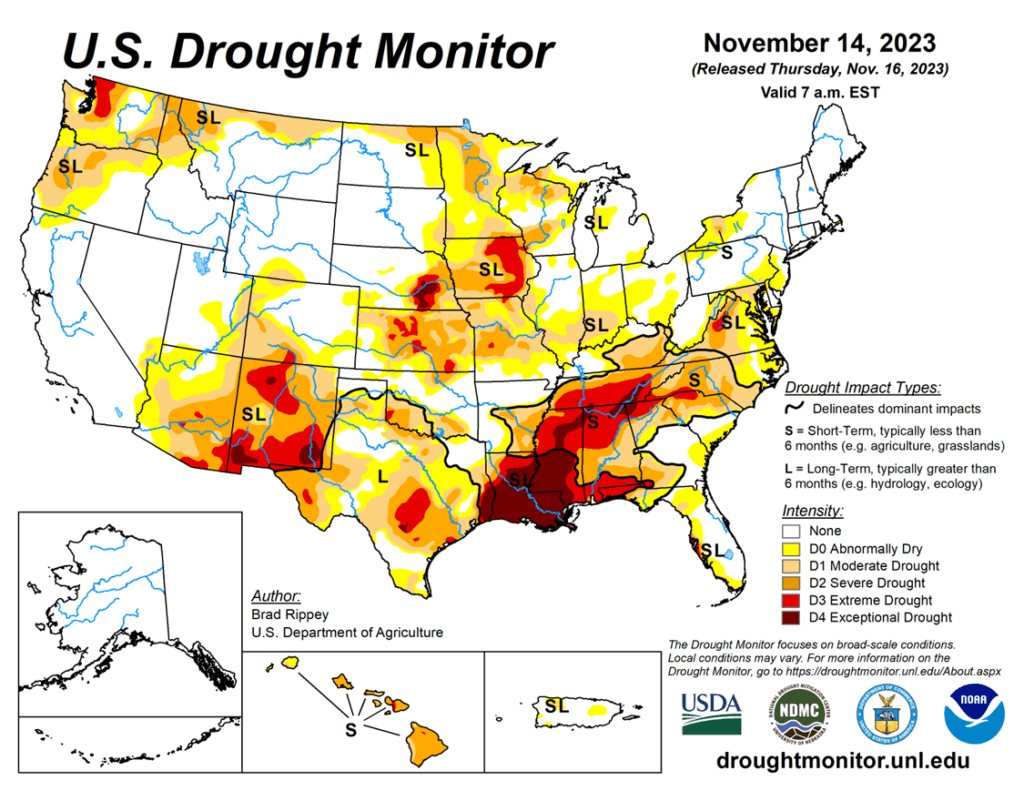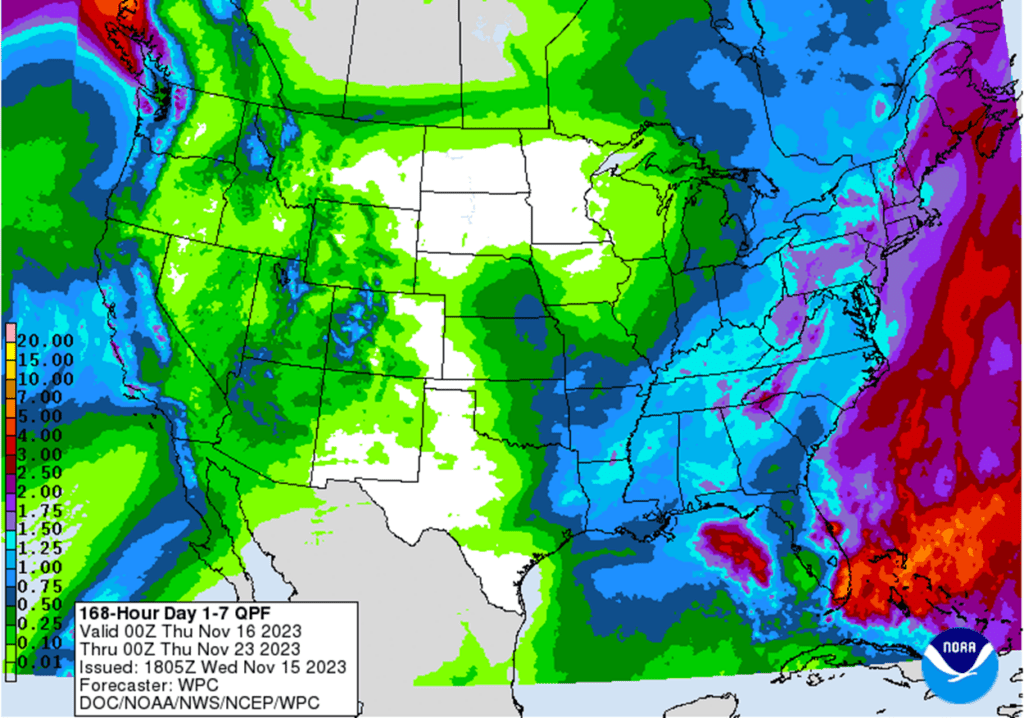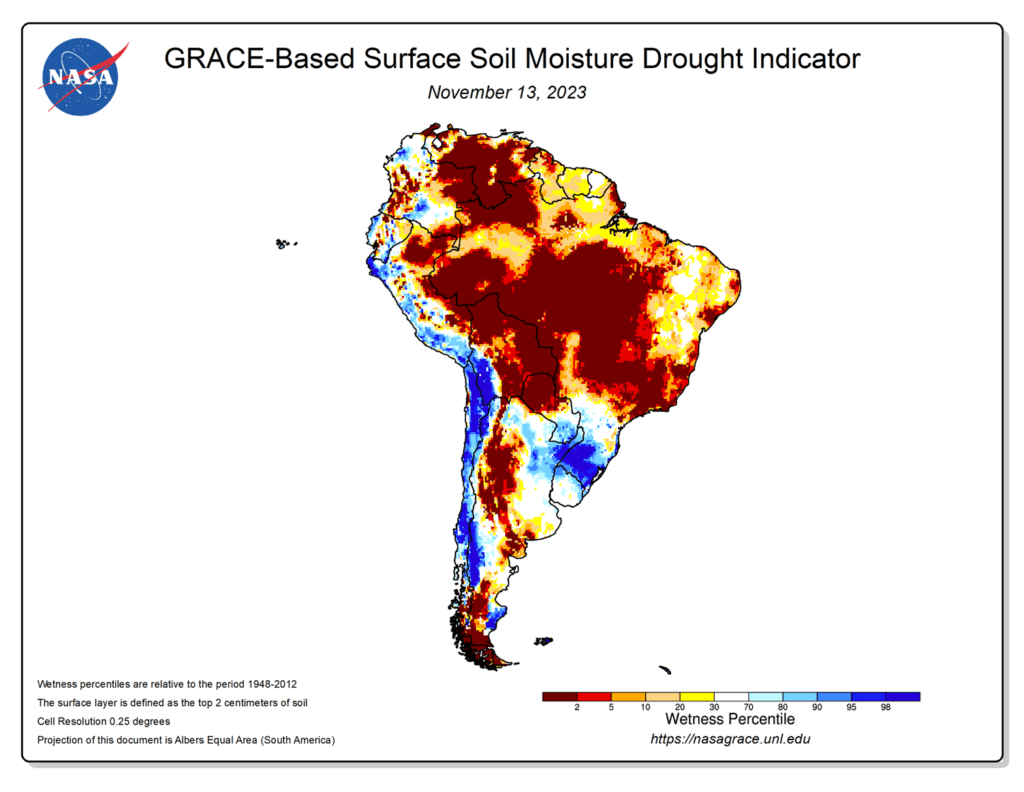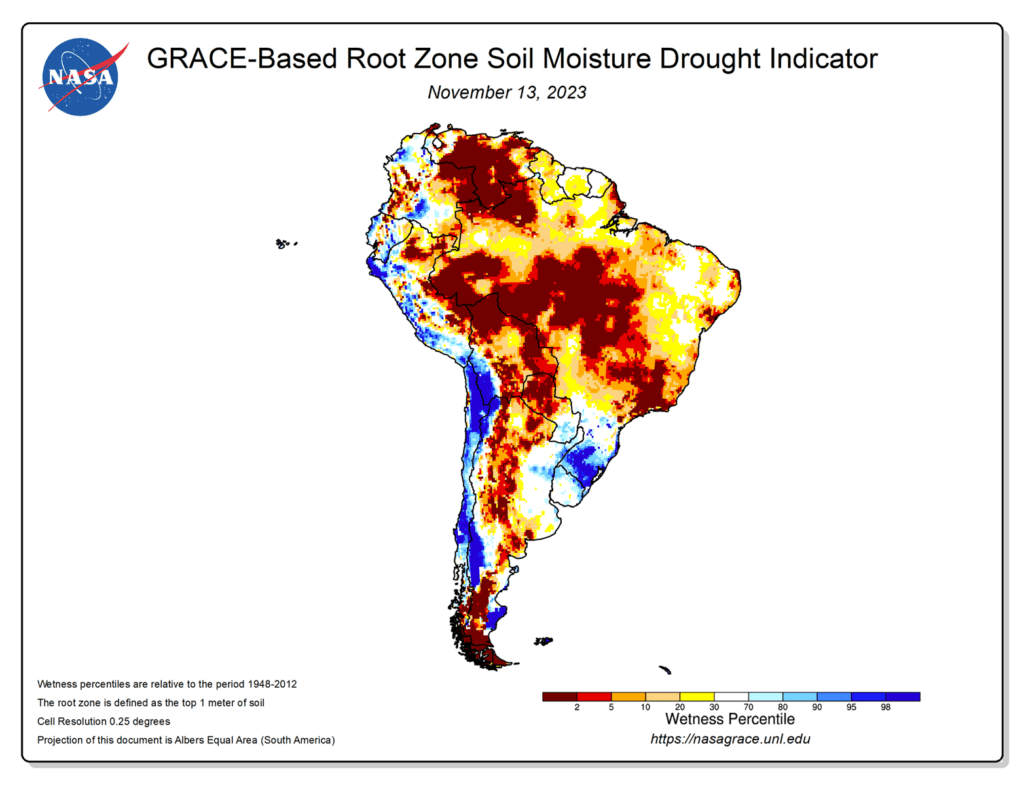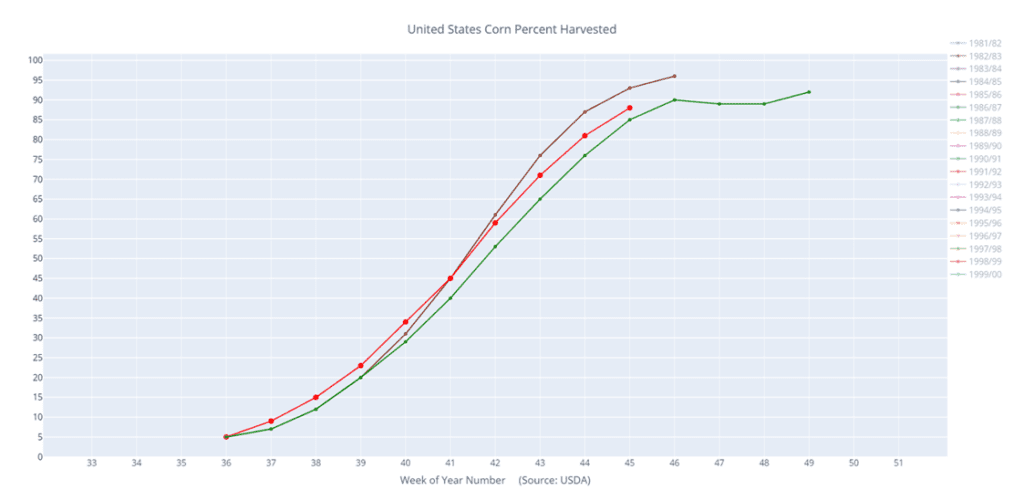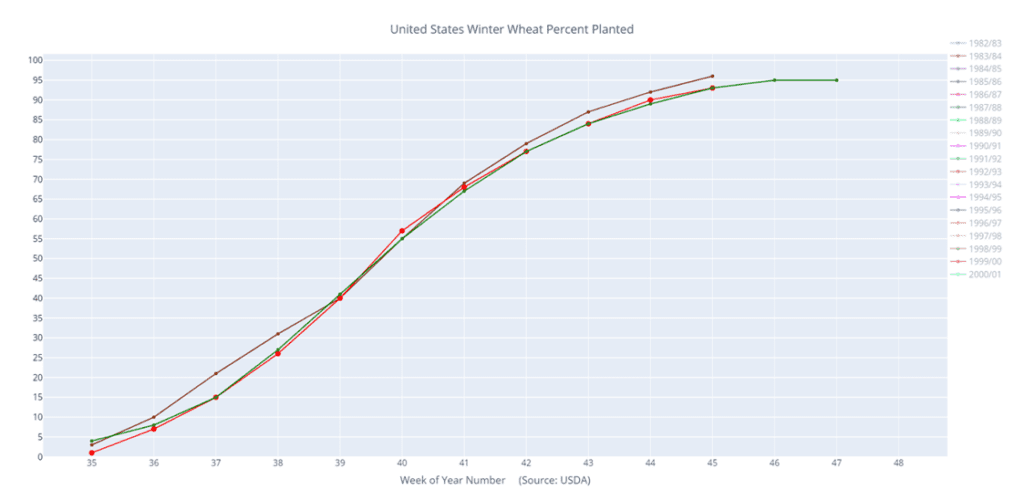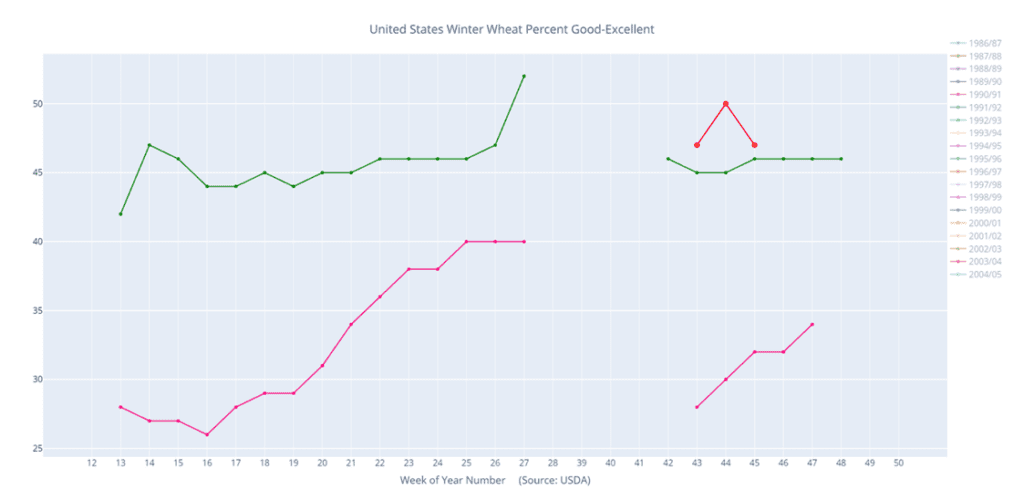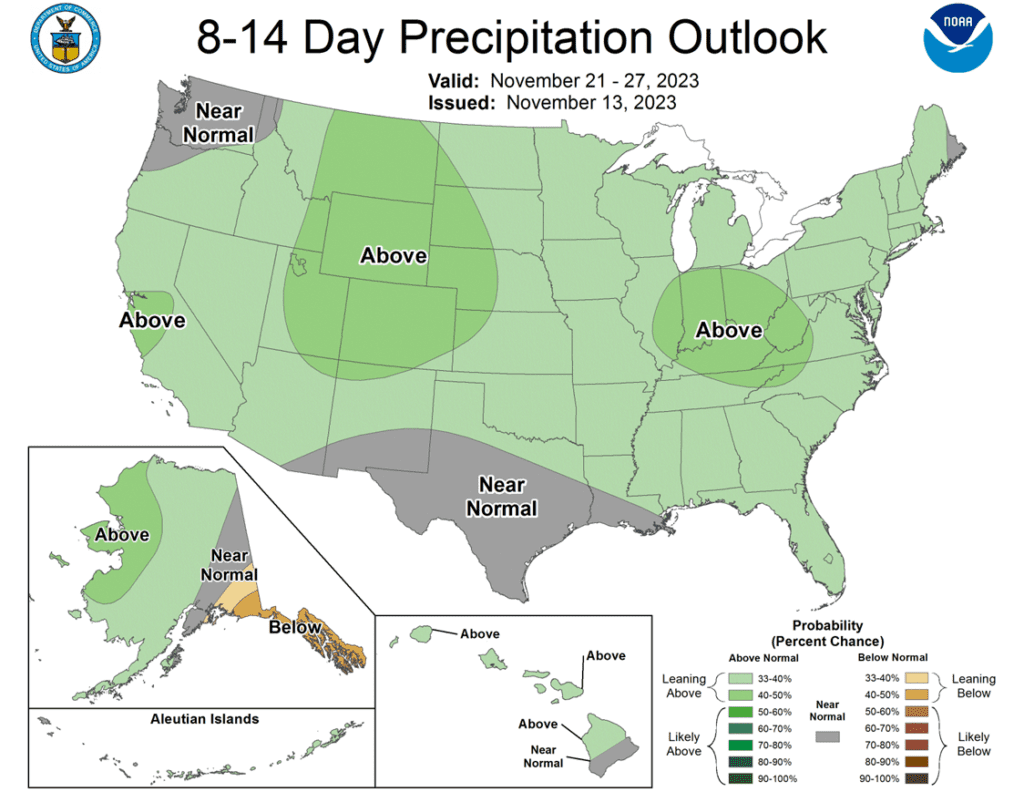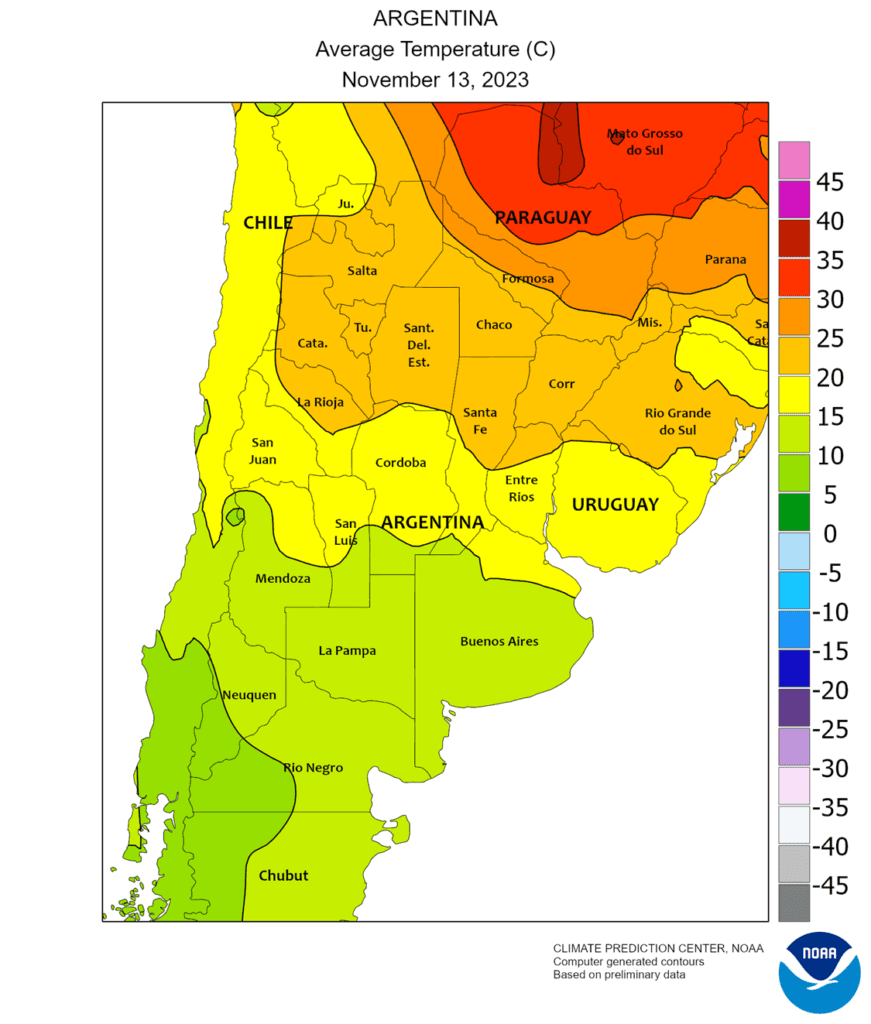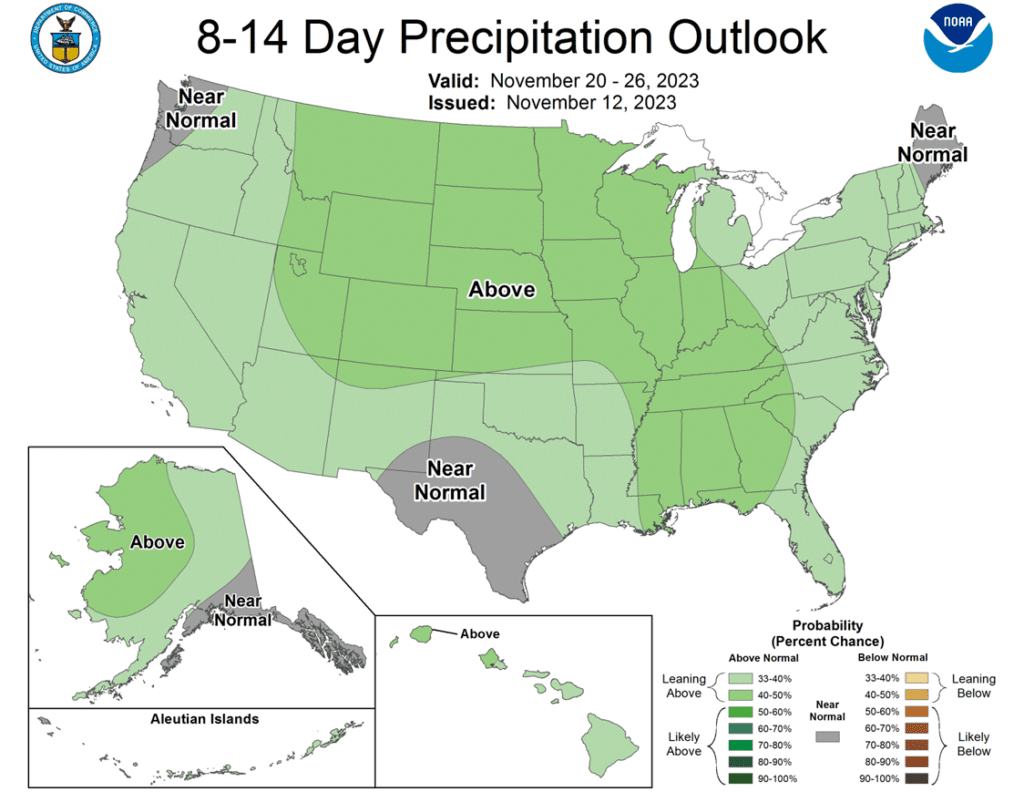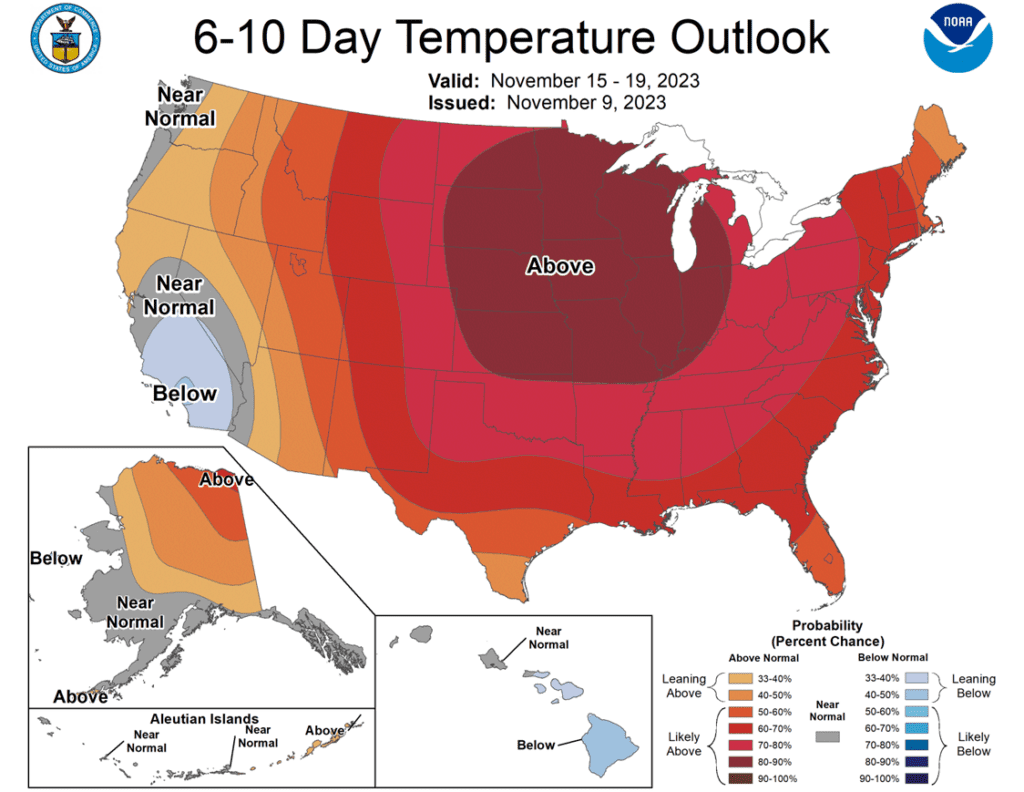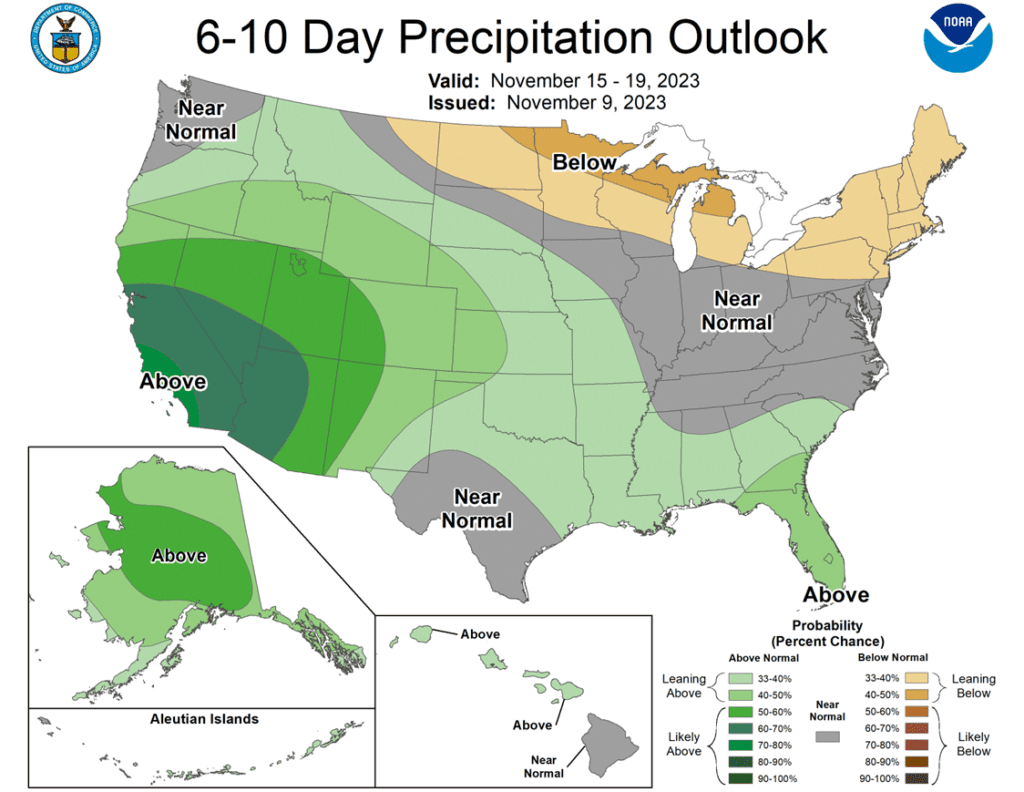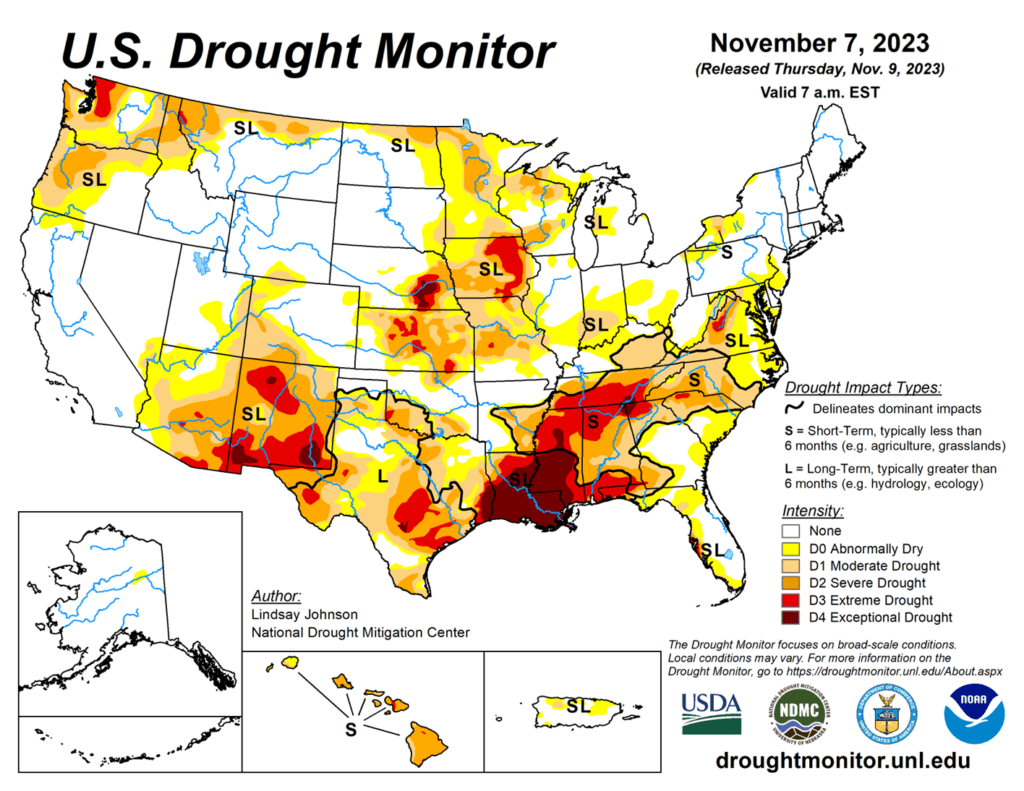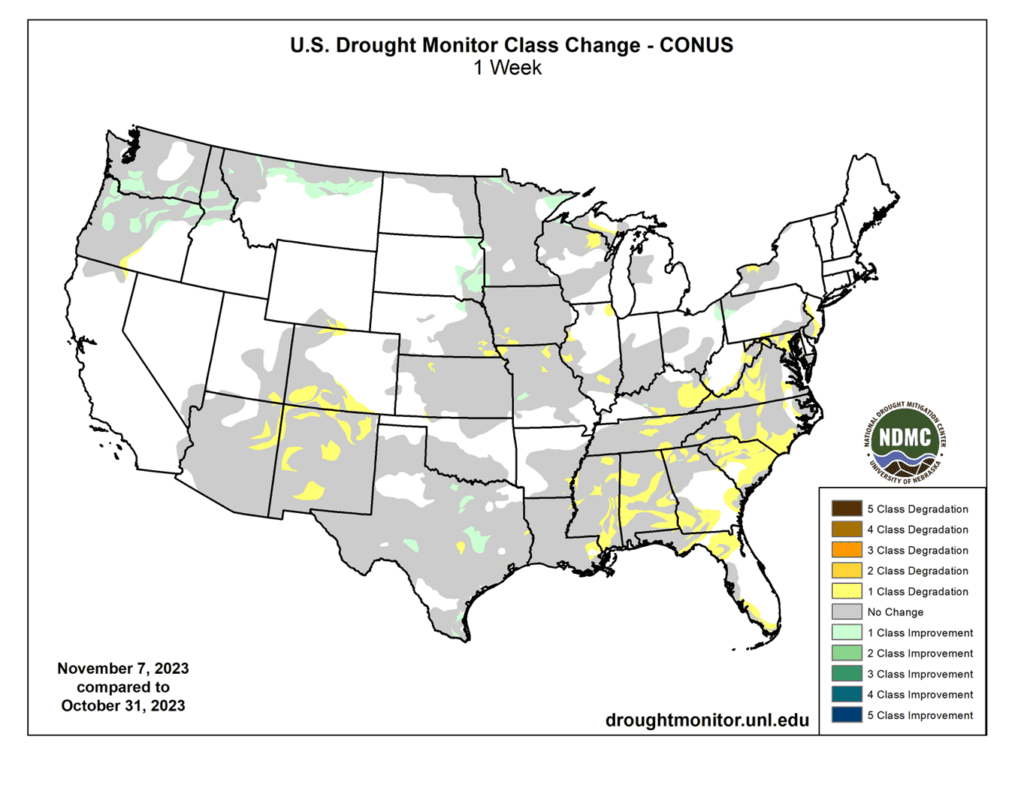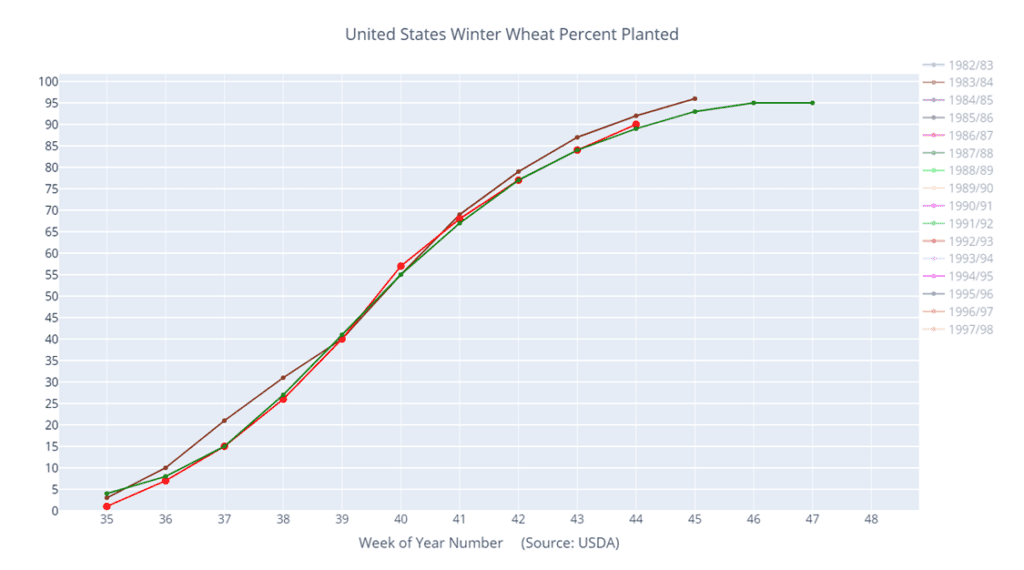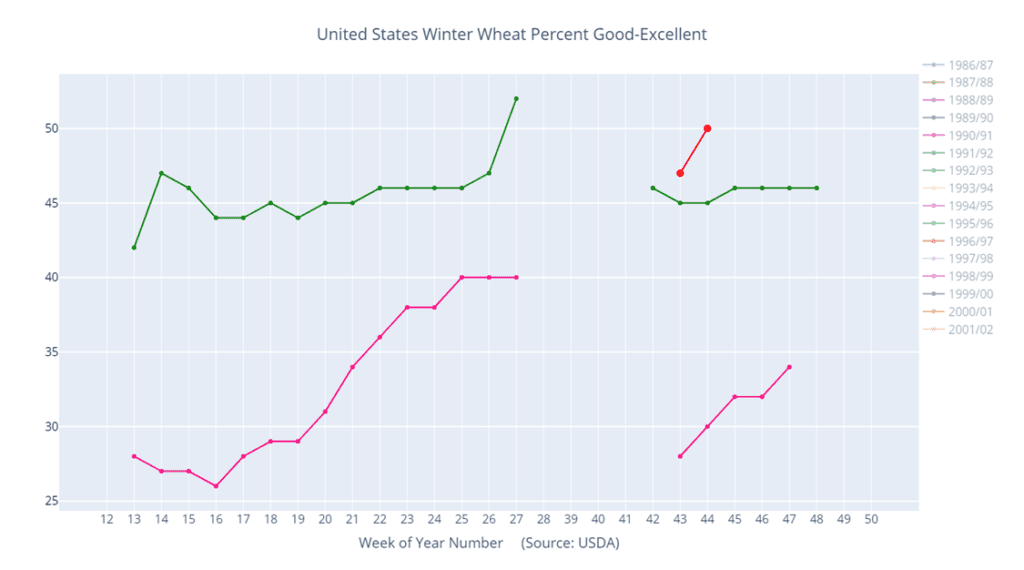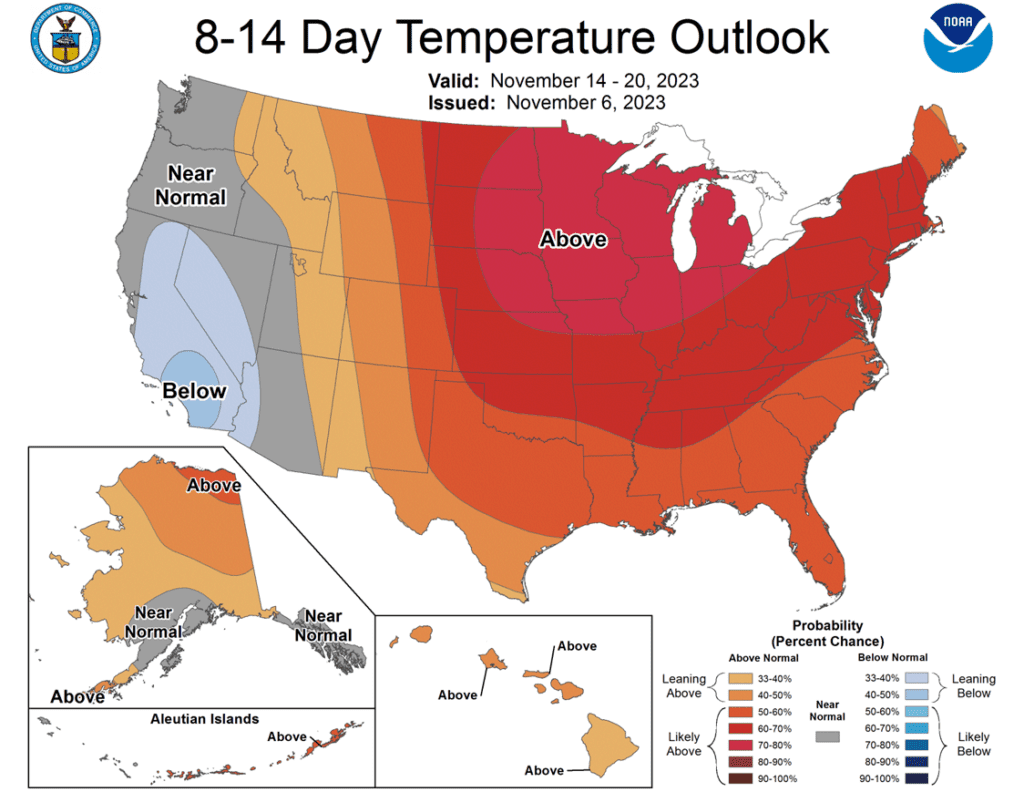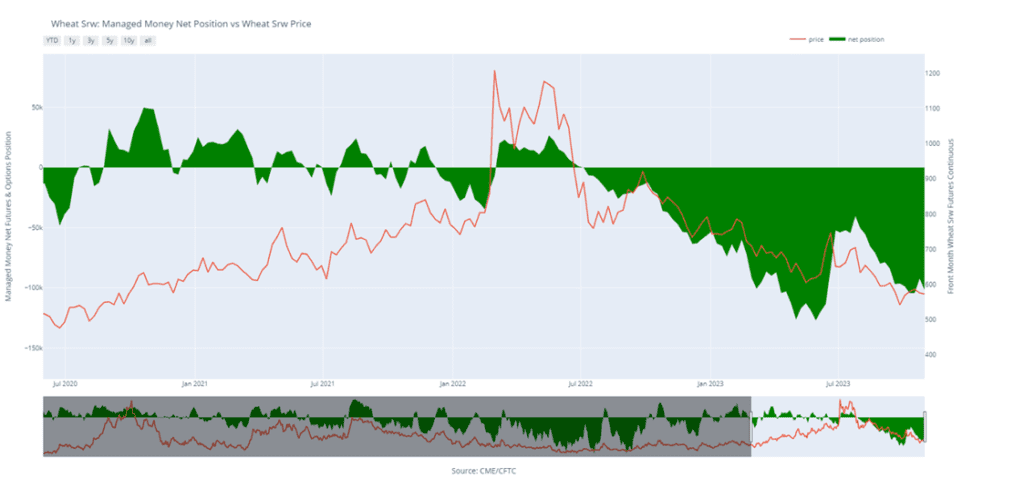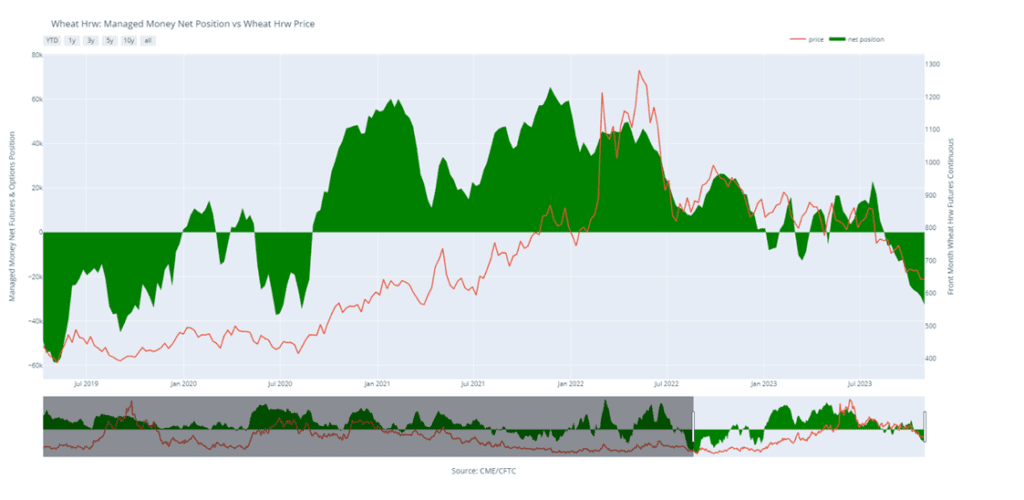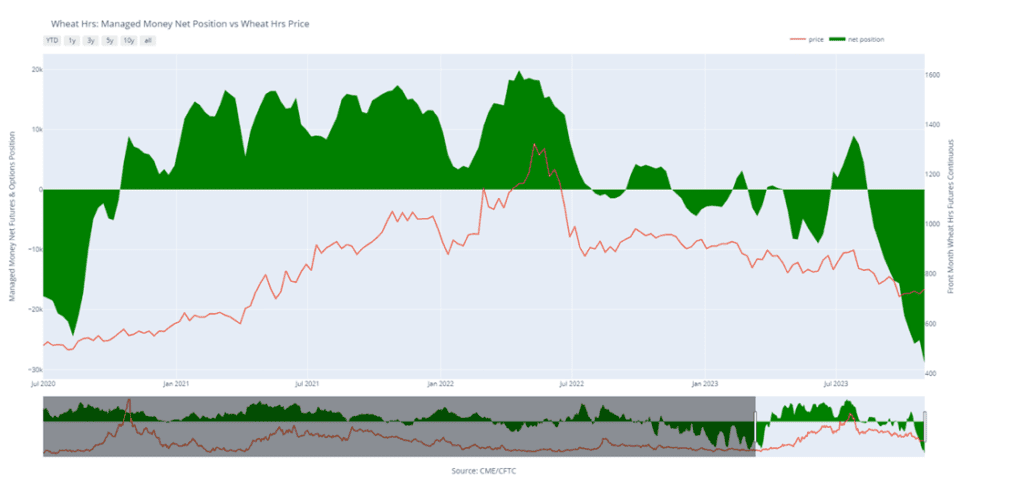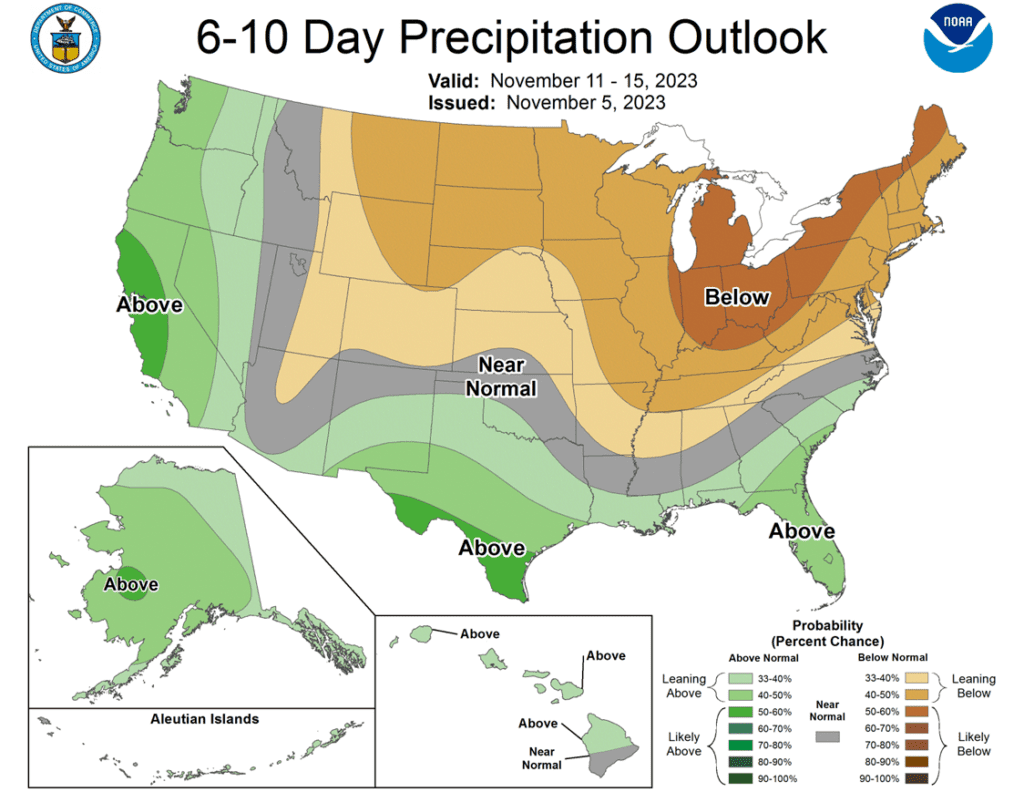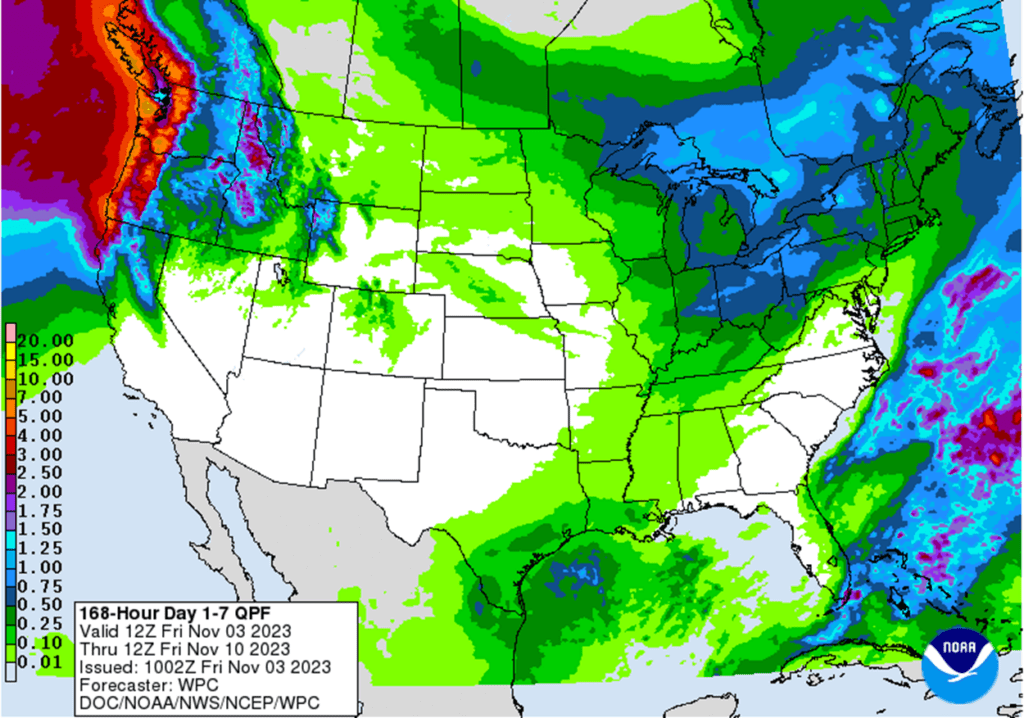11-16 Corn Higher, Beans and Wheat lower in a “Risk Off” Day for Commodities
All prices as of 2:00 pm Central Time
Grain Market Highlights
- Corn futures managed to hang onto gains today as the rest of the grain complex fell lower. Strong weekly export sales helped provide underlying support.
- New forecasts for South America showing much needed precipitation in western and central Brazil this weekend and into the end of the month sparked liquidation in soybeans today.
- Soybean meal and soybean oil followed the commodity trend lower today. WTI crude oil shed over 4% as well, which added to the momentum lower for soybean oil.
- Poor weekly export sales and pressure from outside markets pushed all three wheats lower today.
- To see the updated US Drought Monitor and the Brazil 2 week forecast precipitation, percent of normal, courtesy of the National Weather Service, Climate Prediction Center, scroll down to other Charts/Weather Section.
Note – For the best viewing experience, some Grain Market Insider content is best viewed with your phone held horizontally.
Corn
Corn Action Plan Summary
- No new action is recommended for 2023 corn. Since the beginning of August, the corn market has traded sideways largely between 470 and 500. October’s brief breakout to 509 ½ and the subsequent failure to stay above the 50-day moving average indicates there is significant resistance in that price range. The failure of November’s USDA report to provide a bullish influence on the market puts the market at risk of drifting sideways to lower without a bullish catalyst. During last summer’s June rally, Grain Market Insider recommended making sales when Dec ’23 was around 624. So, for now, the thought process is to hold tight on any further sales recommendations until later this fall or early winter, with the objective of seeking out better pricing opportunities. If the market has not turned around by early winter, then Grain Market Insider may sit tight on the next sales recommendations until spring. If you end up harvesting more bushels than you can store this fall and must move them, consider protecting those sold bushels with either July or September ’24 call options.
- No new action is recommended for 2024 corn. Since late February ’22, Dec ’24 has been bound by 489 ¾ on the bottom and 600 on the top. After testing 491 to 547 last July, it has mostly traded between 500 and 525. During this time, Dec ’24 has held up better as bear spreading has allowed Dec ’24 to maintain more of its value versus Dec ’23 as traders attempt to price in a larger 2023 carryout with more uncertainty remaining for the 2024 crop. Moving forward, the risk for 2024 prices is the same as for 2023 prices, which is a continuation of a lower trend without further bullish input. Grain Market Insider is watching for signs of a change in the current trend to look at recommending buying Dec ’24 call options. This past spring, Grain Market Insider recommended buying 560 and 610 Dec ’23 call options ahead of the summer rally and having those in place helped provide confidence to pull the trigger on recommending 2023 sales into that sharp rally, knowing that if corn kept rallying and went to 700 or 800 that the call options would protect those sold bushels.
- No Action is currently recommended for 2025 corn. Grain Market Insider isn’t considering any recommendations at this time for the 2025 crop that will be planted two springs from now. It will probably be late winter or early spring of 2024 before Grain Market Insider starts considering the first sales targets.
To date, Grain Market Insider has issued the following corn recommendations:
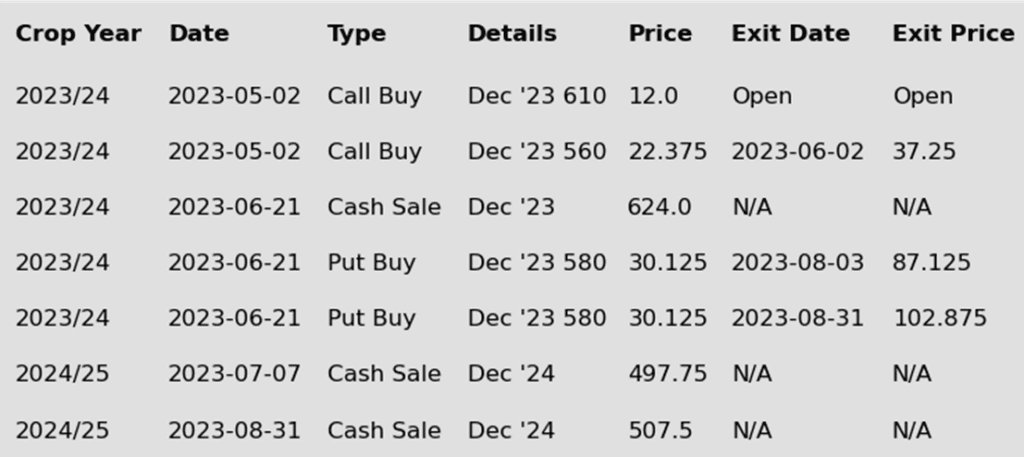
- Corn futures saw positive money flow on Thursday, supported by a better-than-expected Export Sales report for last week. Dec corn futures finished 4 cents higher, but 9 1/2 cents off the session low, despite strong selling pressure in the grain and crude oil markets.
- USDA reported weekly exports sales of 1.808 MMT (71.2 mb) for the current marketing year last week. This was larger than market expectations and brings total sales for the 2023-24 marketing year to 21,098 MMT, up 33% versus last year. Mexico was the top buyer of U.S. corn last week at 41.8 mb.
- Crude oil prices traded over 4% lower during the session on Thursday. The drop in crude oil prices could be a limiting factor and margins for ethanol production could tighten, slowing this key domestic demand.
- Some improving forecast for Brazil helped weigh on soybean prices for the session. Corn futures traded independently from both soybeans and wheat on the day. While Brazil forecast is staying dry overall, a weather wildcard will be Argentina. After two years of drought, conditions are improved, which could lead to price limiting production from the South American country.
- Despite the positive price action on Thursday, Dec corn futures are looking to test key resistance at the $4.80 price level. This price point has been a cap overtop the corn market since the start of November.

Above: The nearby contract in corn has rolled from the December to the March, and while the chart looks like prices made a significant jump, it is in fact the premium in the March that is being represented on the chart. Upside resistance remains between 500 and 509 ½, while support below the market remains 460, with the next major area of support near 415.

Soybeans
Soybeans Action Plan Summary
- No new action is recommended for 2023 soybeans. At the end of August, the soybean market turned lower and didn’t find any significant buying interest until it traded down to 1251 in early October. Since then, the nearby contract has traded through nearby resistance and the 50-day moving average and may be poised to test the August high. Looking back, since last May, nearby soybeans have been in a range from 1435 up top to 1251 down below. Last summer, Grain Market Insider did make two sales recommendations in the 1310 – 1360 price window versus Nov ’23. Given that those sales recommendations were made and given that now is not the time of year to be making many sales, if any, Grain Market Insider is content to hold tight on any further sales recommendations until later this fall or early winter. The focus for strategy right now is to be on the lookout for any call option buying opportunities. If you end up harvesting more bushels than you can store this fall, consider protecting any sold bushels with July or Aug ’24 call options.
- No action is recommended for the 2024 crop. Since the inception of the Nov ’24 contract, it has traded at a discount to the 2023 crop, from as much as 142 back in July, to as little as 17 ¾ in early October during harvest. And while the spread difference between the two crops has seen a good amount of volatility, Nov ’24 has been largely rangebound between 1250 and 1320 since it rallied off its 1116 ¼ low last July. To date, Grain Market Insider has not recommended any sales for next year’s soybean crop. First sales targets will probably be early winter at the soonest. Currently, Grain Market Insider’s focus is also on watching for any opportunities to recommend buying call options.
- No Action is currently recommended for 2025 Soybeans. Grain Market Insider isn’t considering any recommendations at this time for the 2025 crop that will be planted two springs from now, and it may be some time before conditions are conducive to consider making any recommendations. Be patient as we monitor the markets for signs of improvement.
To date, Grain Market Insider has issued the following soybean recommendations:

- Soybeans ended the day lower following a new forecast for South America, which features better chances of rain for Argentina and northern and central Brazil that is expected to begin on Sunday and last until at least the end of the month. Export sales were strong, but were overshadowed by the weather.
- Both soybean meal and oil ended the day lower as well, with a sharp selloff in crude oil which saw prices break support and drop below 73 dollars a barrel. Soybean meal may encounter pressure down the road as Argentina’s soy crop is being planted in better conditions than the previous year, which could allow them to export more soybean meal next year.
- For the week ending November 9, the USDA reported an increase of 144.0 mb of soybean export sales for 23/24, a marketing year high. Last week’s export shipments of 73.2 mb were above the 30.6 mb needed each week to meet the USDA’s expectations. Primary destinations were to China, the Netherlands, and Bangladesh.
- Following a string of sales recently to both China and unknown, another flash sale was reported this morning of 220,000 mt of soybeans for delivery to unknown destinations for 23/24. Since last week, China and unknown destinations have purchased well over 100 mb of soybeans. President Biden and Chinese President Xi met and reportedly had a “productive meeting”.

Above: January soybeans closed sharply higher following a gap higher open on Nov. 13. The development is bullish, though resistance remains between 1385 and 1410, and the market may seek to fill the gap left from 1349 ¾. If the market can close above 1410, it would be poised to make a run toward 1490 – 1505. If not, initial support below the market rests between 1336 and the 50-day moving average near 1317.

Wheat
Market Notes: Wheat
- The markets took a risk off posture today, with many commodities trading lower. All three US wheat futures classes posted losses with KC leading the way down. Paris milling wheat futures offered no support either, with losses of around two Euros per metric ton.
- The USDA reported a dismal increase of 6.5 mb of wheat export sales for 23/24. Each week, 14.8 mb needs to be exported to reach their goal of 700 mb for 23/24, but last week’s shipments totaled only 11.4 mb.
- Adding to pressure in the wheat market is the Australian harvest, with yields so far better than anticipated. However, according to the Australian government, their wheat production will still be over a third lower than last year’s record harvest due to the hot and dry weather this season.
- Ukraine has reportedly began repairing railroads, presumably damaged in the war. This repair work will allow for cargo to be transported to three Black Sea ports near Odesa. These shipments would then be shipped on Ukraine’s humanitarian corridor that was created after Russia left the Black Sea Grain Initiative.
- France is seeing heavy rains and flooding, which may impact the 2024 soft wheat crop, according to FranceAgriMer. France has seen the highest total rainfall ever (for 26 consecutive days) from October 18 to November 12. President Macron is said to be visiting some of the affected areas.
Chicago Wheat Action Plan Summary
- No new action is currently recommended for 2023 Chicago wheat. After making a high in late July, nearby Chicago wheat trended lower until finding support at 540 on September 29, from which it rallied back, briefly piercing 600 and the 50-day moving average. The market now appears to be finding value in the 540 – 616 range established since early September, as weak US export demand, driven by cheap Russian exports, remains the dominant headwind to higher prices. Grain Market Insider made sales recommendations in the late June rally around 720 and again earlier this fall near 604. With those two sales, Grain Market Insider’s strategy is to look for price appreciation going into this winter as weather becomes a more prominent market mover, with an eye on considering additional sales in the 625 – 650 range. If at that point the market remains strong and continues to rally, Grain Market Insider will consider potential re-ownership strategies to protect current sales and add confidence to make additional sales at higher prices.
- No new action is recommended for 2024 Chicago wheat. After retesting the 800 level back in July, new crop Chicago wheat retreated steadily until hitting the late September low of 610 ¼. Since then, prices have been mostly rangebound between 620 and 650. Just as fund positioning and weak fundamentals have driven old crop prices down closer to the mid to upper 500 range and new crop prices to the low to mid 600s. The risk of further new crop price erosion remains without fresh bullish input to move prices higher. At the end of August, Grain Market Insider recommended purchasing July 590 puts to prepare for this possibility, and back in June, Grain Market Insider recommended two separate sales that averaged about 720 to take advantage of the brief upswing. If the market receives the needed stimulus to move prices back toward this summer’s highs, Grain Market Insider is prepared to recommend adding to current sales levels, and possibly even purchasing call options to protect those sales. Otherwise, the current recommended put position will add a layer of protection if prices erode further, and Grain Market Insider will be prepared to recommend covering some of those puts to offset some of the original cost and move toward a net neutral cost for the remaining position.
- No action is currently recommended for 2025 Chicago Wheat. Grain Market Insider isn’t considering any recommendations at this time for the 2025 crop that will be planted next fall. It will probably be mid-winter before Grain Market Insider starts considering the first sales targets.
To date, Grain Market Insider has issued the following Chicago wheat recommendations:


Above: The nearby contract in corn has rolled from the December to the March, and while the chart looks like prices made a significant jump, it is in fact the premium in the March that is being represented on the chart. Upside resistance remains between 604 ½ and 618, while support below the market may be found between 564 and 554.
KC Wheat Action Plan Summary
- No new action is recommended for 2023 KC wheat crop. Since late July the nearby KC wheat has been in a downtrend that has had periods of relative stability, but not any significant reversals higher. The market once again found nearby support as it traded to, and held, its recent low of 625 ½. Currently, weak US export demand, driven by cheap Russian exports, remains the dominant headwind, and the market is in need of bullish input to stabilize and rally prices back higher. If a bullish catalyst enters the market to push prices above 700, it may signal that a fall low is in place and would line up with the historical tendency for prices to appreciate into winter and early spring. Grain Market Insider’s strategy is to look for price appreciation going into this winter, as weather becomes a more prominent market mover with an eye on considering additional sales near 750 – 800. If at that point the market remains strong and continues to rally, Grain Market Insider will consider potential re-ownership strategies to protect current sales and add confidence to make additional sales at higher prices.
- No new action is recommended for 2024 KC wheat. Back in July, the July ’24 contract tested the 870 range, while Dec ‘23 was testing the 930 level. Since then, fund positioning and weak demand fundamentals have driven both the nearby old crop contracts and July ’24 prices lower, with nearby old crop prices now in the low to mid 600s, while July ’24 retains about a 15 cent premium. The risk for the July ’24 contract remains the same as for the nearby old crop contracts, in that the market needs fresh bullish input to move prices higher, and without it, prices may continue to erode. In mid-August, Grain Market Insider recommended purchasing July 660 puts to prepare for this possibility, and back in July, Grain Market Insider recommended a sale near 800 to take advantage of elevated prices before they eroded further. If the market receives the needed impetus to move prices back toward 750 – 800, Grain Market Insider is prepared to recommend adding to current sales levels. Otherwise, the current recommended put position will add a layer of protection if prices erode further, and Grain Market Insider will be prepared to recommend covering some of those puts to offset some of the original cost and move toward a net neutral cost for the remaining position.
- No action is currently recommended for 2025 KC Wheat. Grain Market Insider isn’t considering any recommendations at this time for the 2025 crop that will be planted next fall. It will probably be mid-winter before Insider starts considering the first sales targets.
To date, Grain Market Insider has issued the following KC recommendations:


Above: Since breaking through the bottom of the consolidation range at 655, the market has drifted lower and tested minor support which has held so far with the low at 625 ½. The next level of major support below that remains near 575. Major resistance above the market remains around 690 – 700.
Mpls Wheat Action Plan Summary
- No new action is currently recommended for the 2023 New Crop. After making highs in July, and the subsequent downtrend to the October 2 low of 707 ½, nearby Minneapolis wheat has traded mostly sideways with no significant reversal higher. With weak US export demand still the primary impediment to higher prices, the market remains at risk of trending lower if September’s low close of 709 is violated to the downside unless another bullish impetus enters the scene. If that happens and prices begin to push back toward 775, it may signal that a near-term low is in place. Earlier this year, Grain Market Insider made a sales recommendation during the July rally near 820, and with that sale in place, Grain Market Insider’s strategy is to look for price appreciation going into this winter with an eye on considering additional sales around 750 – 800, and again north of 825. If at that point the market remains strong and continues to rally, Grain Market Insider will consider potential re-ownership strategies to protect current sales and add confidence to make additional sales at higher prices. Even though the primary strategy is to look for higher prices, Grain Market Insider may also consider a “plan b” in the next couple of weeks if prices grind sideways to lower.
- No new action is currently recommended for 2024 Minneapolis wheat. In the last three months, the Sep ’24 contract has gone from a 60 – 80 discount to Dec ’23, to a 50-cent premium. Weak fundamentals led bear spreading to drive Dec ’23 in search of new contract lows, while Sep ’24 remains off its low from last May. The risk for the Sep ’24 contract is much like that of Dec ’23. The market needs bullish input to move prices higher, and without it, prices may continue to erode. In mid-August, Grain Market Insider recommended purchasing July KC 660 puts (for their greater liquidity, and correlation to Minneapolis pricing) to prepare for this possibility, and back in July, Grain Market Insider recommended a sale near 815 to take advantage of elevated prices. If the market receives the needed stimulus to move prices back toward 800, Grain Market Insider is prepared to recommend adding to current sales levels. Otherwise, the current recommended put position will add a layer of protection if prices erode further. Grain Market Insider will then be prepared to recommend covering some of those puts to offset some of the original cost and move toward a net neutral cost for the remaining position.
- No action is currently recommended for the 2025 Minneapolis wheat crop. Grain Market Insider isn’t considering any recommendations at this time for the 2025 crop that will be planted two springs from now. It will probably be mid-winter before Grain Market Insider starts considering the first sales targets.
To date, Grain Market Insider has issued the following Minneapolis wheat recommendations:


Above: The nearby contract in corn has rolled from the December to the March, and while the chart looks like prices made a significant jump, it is in fact the premium in the March that is being represented on the chart. Nearby resistance remains near 755 with heavy resistance above the market near the September high of 791. Below the market initial support lies near 721, with major support down near 669, the May ’21 low.

Other Charts / Weather
